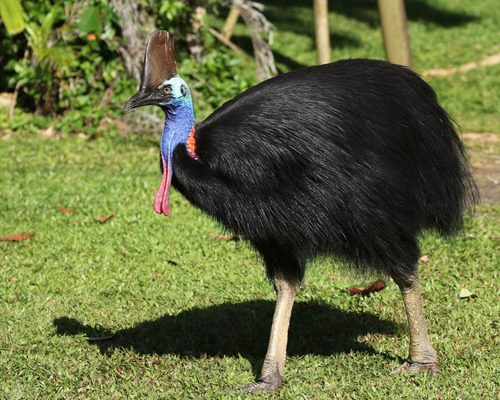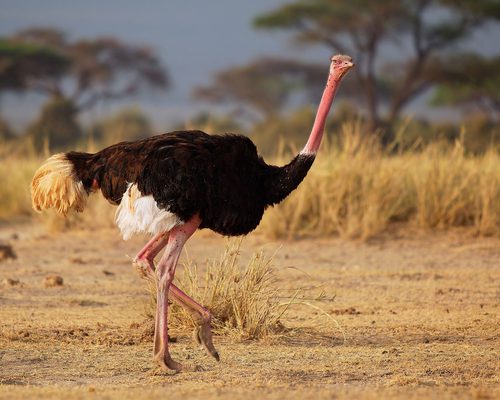Emu
Least ConcernDromaius novaehollandiae
Visual Identification
Appearance
The Emu is a flightless bird with a tall, upright stance and long neck. Its body is covered in shaggy, greyish-brown feathers that resemble fur. The head and neck have sparse, black, bristly feathers, and its legs are long and powerful.
Adult Emus stand 1.5 to 1.9 meters tall. Both sexes look similar, though females are slightly larger on average. Juveniles have distinctive brown and cream striped plumage until about 3 months old.
Size
Length
150cm to 190cm
Wingspan
16cm to 25cm
Weight
30kg to 55kg
Colours
Males and females have similar plumage
Primary Colour
Brown Grey
Secondary Colour
Black
Beak Colour
Black Grey
Leg Colour
Brown
Habitat and Distribution
Habitats
Woodland
Garden
Wetland
Coastal
Urban
Farmland
Grassland
Desert
Tundra
Rainforest
Mountain
Savanna
Distribution
Emus are found throughout mainland Australia, inhabiting many habitats, including grasslands, sclerophyll forests, and savannahs. They are absent from Tasmania, rainforests, and densely populated areas.
While generally non-migratory, Emus are nomadic and may travel long distances due to rainfall and food availability. They are well-adapted to Australia's varied climate zones, from arid interior regions to more temperate coastal areas.
Elevation Range
Sea level to 1100 meters
Climate zones
Arid, Subtropical, Temperate
Distribution Map
This map gives you a rough idea of where you might spot a Emu. The coloured areas show countries where these birds have been seen.
A few things to keep in mind:
- Birds might not be everywhere in the coloured areas, for example, they may be present around the coast of that country
- Where birds live can change with seasons and available food
- This map is quite simple - it doesn't show exact locations
We're working on making our maps even better! Soon, we hope to show you:
- More detailed maps for bigger countries, including state and region
- How birds move around during different seasons
Distribution by Region
Behaviour and Ecology
Bird Attributes
This feature is in beta. We'd love your feedback to improve it!
Share your thoughtsBird Attributes Explained
Our bird attributes system rates various aspects of a bird's capabilities on a scale of 0-100, based on data from field observations, scientific studies, and expert knowledge.
Attribute Categories:
- Agility: Manoeuvrability, speed, and grace in flight or movement.
- Strength: Physical power, often correlating with size and hunting abilities.
- Adaptability: Ability to thrive in various environments or changing conditions.
- Aggressiveness: Territorial behaviour and assertiveness, particularly during breeding seasons.
- Endurance: Stamina, often seen in migration patterns or foraging behaviours.
Understanding the Ratings:
- 0-20: Very Low
- 21-40: Low
- 41-60: Average
- 61-80: High
- 81-100: Very High
Remember, these attributes are relative to other bird species and don't necessarily indicate superiority.
Hover over the icon next to each attribute for more information.
Tap the icon next to each attribute for more information.
Agility
Reflects the bird's manoeuvrability, speed, and grace in flight or movement.
Emus possess remarkable agility for their size. They can sprint at speeds up to 50 km/h and are excellent swimmers, demonstrating impressive manoeuvrability across various terrains.
Strength
Indicates the bird's physical power, often correlating with size and hunting abilities.
With powerful legs and a robust build, Emus exhibit considerable strength. Their ability to defend against predators and travel long distances in harsh conditions attests to their physical prowess.
Adaptability
Represents the bird's ability to thrive in various environments or changing conditions.
Emus display exceptional adaptability, thriving in diverse habitats from arid interiors to temperate coastal areas. Their nomadic lifestyle and ability to survive weeks without food showcase their adaptiveness.
Aggressiveness
Measures the bird's territorial behaviour and assertiveness, particularly during breeding seasons.
While generally not overly aggressive, Emus can be territorial and potentially confrontational, especially when protecting their young. Their size and powerful kicks make them formidable when threatened.
Endurance
Reflects the bird's stamina, often seen in migration patterns or foraging behaviours.
Emus demonstrate remarkable endurance, capable of travelling long distances in search of food and water. Their ability to thrive in harsh Australian environments and go extended periods without eating highlights their exceptional stamina.
Diet
Emus are omnivorous, primarily feeding on plants, including fruits, seeds, and shoots. They also consume insects, small vertebrates, and animal droppings.
These birds require stones and pebbles to aid in grinding food in their gizzards, and they can go weeks without eating when food is scarce.
Behaviour
Emus are nomadic, travelling long distances in search of food and water. They are excellent runners, capable of sprinting at speeds up to 50 km/h. These birds are generally solitary but may form large flocks when food is abundant. They communicate through various vocalisations and are known for their curiosity towards unfamiliar objects.
Vocalisation
Emus produce a variety of sounds, but their most distinctive vocalisation is a low, booming call that can be heard up to 2 kilometres away. This sound is created by inflating a neck sac and sounds like 'e-moo'. They also make grunts, hisses, and drumming noises, especially when threatened.
Nesting & Breeding
Emus typically breed during the Australian winter and spring. To attract females, males perform elaborate courtship displays, including neck swelling and booming calls.
The male constructs a simple nest on the ground, often near a bush or tree for protection. Females lay 5-15 large, dark green eggs in the nest.
Unusually among birds, the male is solely responsible for incubation, which lasts about 8 weeks. He also cares for the chicks for up to 18 months, defending them against predators and teaching them to forage.
Lifespan
years
The Emu typically lives for 10 to 20 years.
Like all birds, lifespan can be affected by factors including predation, habitat quality, disease, and access to food sources.
Conservation and Status
Global Conservation Status
While listed as Least Concern globally, Emu populations face localised threats from habitat loss and fragmentation due to agriculture and urban development.
Some states in Australia have implemented conservation measures to protect Emu habitats and maintain sustainable populations.
Birdwatching Tips
- Look for Emus in open grasslands, savannahs, and woodlands across Australia
- Listen for their distinctive booming, drumming calls
- Observe from a safe distance, as Emus can be territorial and potentially aggressive
- Visit national parks and reserves in Australia for the best chances of spotting Emus in the wild
Additional Information
Quick Facts
Other names:
Australian Emu
Family:
CasuariidaePredators
Adult Emus have few natural predators due to their size, but dingoes, wedge-tailed eagles, and introduced foxes may prey on chicks and eggs.
Did You Know?
- Emus can't walk backwards.
- They are excellent swimmers and often enjoy bathing in water.
- Emu feathers have two shafts emerging from a single quill, a unique feature among birds.
Was this bird profile helpful?
Your feedback helps us improve our content
Thanks for your feedback!
Your input helps us improve our content.
Community Experience
Community Ratings
No ratings yet - be the first to rate this bird!
Latest Community Reviews
No reviews yet
Sign in to be the first to review
Community Reviews
Create Your Free Account Welcome Back!
Join our community to rate birds and share your experiences. Creating an account is completely free and only takes a minute. Sign in to your account to rate birds and share your experiences with our community.
Your information is secure and will never be shared.
By creating an account, you agree to our Privacy Policy.
Similar Birds
References
- 1
website: BirdLife International. 2018. Dromaius novaehollandiae. The IUCN Red List of Threatened Species 2018: e.T22678117A131902466.
View source - 2 3
report, 1992: del Hoyo et al.

